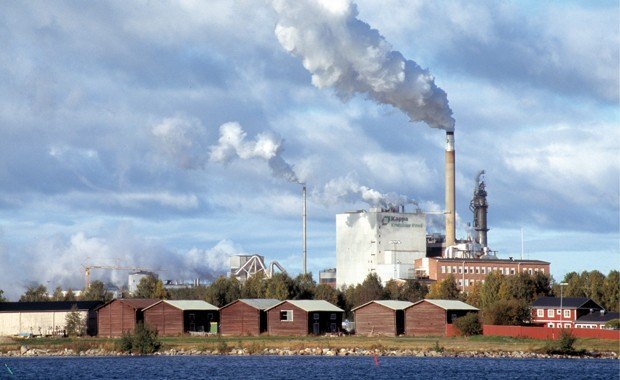
The paper industry is one of the highest energy consumers. Pictured above a paper-factory in Piteå, Sweden. Photo: SCANPIX
Market oversupply meant that consumers benefited from low prices. The de-regulation and consequent combination and interconnection of several national markets also meant that it was unnecessary to cater for large national oversupply. This means that demand can increase without an equivalent increase in supply because better utilisation of the assets and the system exists. A well functioning liberalised market can operate with a tighter balance of supply and demand than a strictly monopolised market with little or no trade with other markets. De-regulation has led to lower prices for all consumers compared to what the prices would otherwise have been, particularly in the first years after de-regulation.
The demand side in the Nordic market has, broadly, three types of consumers; households, power intensive industry and other businesses. Each accounts for roughly 1/3 of total consumption. It is however probably the power intensive industry sector in particular that is likely to present the greatest challenges. For many years these industries have benefited from low (subsidised) power prices. Latterly, however, these beneficial power contracts have been phased out. The argument here is that the market should be equal for everyone.
On the other hand, if these industries have to pay market price for electricity, their profitability will plummet. In fact the consequence may be that the whole sector simply relocates away from the Nordic region. This in turn would see the Nordic electricity market once again having a massive over capacity of supply.
The power-intensive industry sector across Europe is however faced with the same problems as their Nordic counterparts. As such European industry bodies are lobbying intensively to avoid paying market price for their power. Whether this debate can influence future scenarios for the Nordic power intensive industry sector remains however to be seen.
By Vivi Mathiesen, Senior Adviser, Nordic Energy Research - www.nordicenergy.net
New infrastructure:
Prioritised cross sections
- Fenno-Skan 2 (800 MW, Finland-Sweden, commissioning autumn 2010)
- Nea-Järpströmmen (200 MW, later 750 MW, commissioning mid 2009)
- Sydlänken, cross section 4 (4-600 MW, commissioning 2011/12)
- Storebælt (600 MW, connecting east and west Denmark, commissioning 2009)
- Skagerrak IV (600 MW, southern Norway-Denmark, commissioning 2012 at the earliest)
Source: Nordel (2006)
Generation mix1
Power generation in the Nordic market comes from the following sources:
- 50% hydro-power (mainly Norway and Sweden)
- 10% gas and oil-fired power (mainly Denmark and Finland)
- 10% coal-fired power
- 20% nuclear power
- 10% wind power, bio-fuels and other small scale renewables (mainly Denmark and Finland)
Source: E-CO Energi (2006) www.e-co.no
1) These are approximate numbers as the generation mix will vary with the level of rainfall: heavy rainfall will result in a higher share of hydro-power.